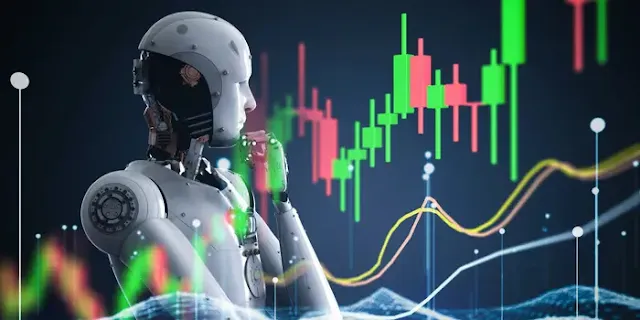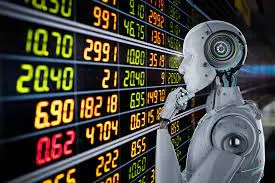Brainy Share Markets: How AI Is Reshaping Stock Trading
Integrating Artificial Intelligence (AI) in the share market has transformed the analysis, interpretation, and utilisation of financial data. AI-driven tools now empower traders, investors, and financial institutions with sharper insights, faster decisions, and more accurate predictions. As markets grow more complex, AI redefines strategies, offering an astute and more responsive approach to investing. Artificial Intelligence (AI) has emerged as a game-changer in the dynamic world of the share market. By processing vast volumes of data in seconds, AI enables faster, smarter, and more accurate decision-making. AI identifies hidden patterns, detects market trends, and predicts stock movements accurately. Its real-time analysis and learning capabilities help investors respond swiftly to market shifts, making AI an essential tool for modern financial strategies.
What is Artificial Intelligence (AI), and how is it applied in the share market?
- Artificial Intelligence (AI) simulates human intelligence by enabling machines to think, learn, and solve problems. These systems can process large volumes of data, recognise patterns, make predictions, and continuously improve performance without direct human involvement. AI is a powerful tool that transforms trading and investment decisions in the share market.
- Financial markets generate massive amounts of data every second. Traditional methods often fail to keep pace with this speed and complexity. AI overcomes this limitation by analysing historical and real-time data rapidly and accurately. It studies stock movements, trading volumes, company reports, global news, and social media sentiment to generate actionable insights. This ability to process and interpret multi-dimensional data allows AI to forecast market trends with improved precision.
- Traders use AI to develop complex algorithms that execute buy or sell orders within milliseconds. These AI-driven models learn from past market behaviour and adapt to market conditions. Portfolio managers apply AI to optimise asset allocation, rebalance portfolios, and reduce exposure to market volatility. Regulatory bodies now deploy AI tools to detect market manipulation and insider trading activities.
- By blending speed, accuracy, and adaptability, AI has redefined how investors and institutions participate in the share market. It moves beyond guesswork and emotions, offering data-backed strategies that respond intelligently to changing market conditions. AI is no longer a futuristic concept—it is an active force shaping the present and future of stock market operations.
How does AI enhance decision-making in trading and investment?
- AI enhances decision-making in trading and investment by delivering faster, more precise, and data-driven insights that go far beyond human capability. In the share market, timing and accuracy are critical. AI supports both by analysing massive volumes of data in real-time and identifying overlooked patterns.
- AI improves decision-making through predictive analytics. AI models use historical market data, price trends, trading volumes, and macroeconomic indicators to forecast future stock movements. These predictions help traders and investors make well-informed decisions based on probabilities rather than assumptions. AI constantly learns from new data, so its recommendations evolve with the market.
- AI also eliminates emotional bias and human judgment during high-volatility trading. Unlike human traders, AI does not panic during market dips or get greedy during rallies. It follows clear logic, which results in more consistent and objective decisions.
- AI-driven systems also monitor global news, financial reports, and social media trends. They quickly assess how these external events could influence market sentiment and adjust investment strategies accordingly. This proactive approach reduces risk and improves overall performance.
How does AI help in predicting stock price trends and market behaviour?
- AI helps in stock price trends and market behaviour by analysing complex data patterns, identifying correlations, and generating forecasts with speed and accuracy. Traditional forecasting methods often rely on limited historical data and static models. In contrast, AI uses dynamic, self-learning algorithms that adapt to changing market conditions daily.
- Machine learning, a core branch of AI, plays a prime role in stock market prediction. These models process vast historical data like stock prices, trading volumes, economic indicators, company earnings, and sector performance. They identify hidden relationships and recurring patterns that may signal future price movements. Over time, the system learns which factors most influence specific stocks or sectors and adjusts its predictions accordingly.
- AI also incorporates alternative data sources such as social media sentiment, news headlines, political developments, and global events. Natural language processing (NLP) allows AI to interpret the tone and context of such content. If a major company faces a crisis or a positive breakthrough, AI can quickly assess the likely impact on stock prices and recommend action before the broader market reacts.
- In addition, AI detects micro-trends and price fluctuations that occur within seconds—something human analysts cannot do manually. High-frequency trading firms use this capability to gain an edge by capitalising on tiny price movements. On a larger scale, AI supports long-term trend analysis by continuously feeding on new data, retraining its models, and reducing prediction errors.
- AI does not offer guarantees, but it improves the quality of market forecasts by basing them on logic, evidence, and adaptability. In a market driven by uncertainty and rapid change, this level of insight becomes a powerful tool for individual and institutional investors.
How does AI work on the stop-loss process?
- AI improves the stop-loss process by making it more intelligent, adaptive, and responsive to real-time market conditions. Traditionally, traders set stop-loss orders manually based on fixed price levels. These static points often fail to respond to sudden market shifts or changing volatility. AI changes this approach by continuously monitoring the market and adjusting stop-loss triggers dynamically.
- AI-powered systems analyse historical price movements, volatility patterns, and trading behaviour to calculate optimal stop-loss levels. AI uses real-time data to set stop-loss levels that balance risk and protection, avoiding guesswork or rigid percentages. This process reduces the chances of premature exits due to normal market noise or minor price fluctuations. Machine learning algorithms learn from past trades and refine their decisions over time. They recognise which stop-loss strategies worked under specific market conditions and adjust accordingly.
- AI also works with trailing stop-loss mechanisms. As the stock price rises, the AI adjusts the stop-loss upward, locking in gains while still allowing room for upward movement. If the price begins to fall beyond a calculated threshold, AI executes the exit automatically, protecting the trader from the most preponderant losses.
In what ways does AI assist in risk management and fraud detection?
- AI assists in risk management and fraud detection by identifying hidden threats, analysing patterns, and responding to anomalies faster than any manual system. In risk management, AI continuously scans market data, news feeds, economic indicators, and portfolio performance to detect early signs of volatility or downturns. It assesses potential losses, adjusts asset allocations, and recommends strategies to minimise exposure in real-time.
- In fraud detection, AI monitors trading activities and financial transactions to spot irregular behaviour. Machine learning models learn from historical fraud cases and recognise unusual patterns such as insider trading, market manipulation, or abnormal order flows. Natural language processing tools further help by analysing communication, reports, and social media for signs of misleading or deceptive practices.
- AI detects threats but also predicts them, allowing firms to act proactively. By automating these processes, AI improves accuracy, reduces response time, and strengthens the integrity of financial systems. Its ability to learn and adapt ensures that detection methods stay effective even as fraudulent tactics evolve.
How do I use AI in the RSI (Relative Strength Indicator) oscillator?
- You can use AI in the RSI (Relative Strength Index) oscillator by combining traditional RSI calculations with machine learning to enhance accuracy, timing, and strategy. Here's how it works:
- AI analyses historical RSI data with other indicators, price movements, and trading volumes to identify patterns that signal powerful buy or sell opportunities. Instead of using fixed RSI thresholds like 30 or 70, AI adjusts these dynamically based on market conditions, volatility, and asset behaviour.
- Machine learning models also learn from past RSI-based trades to refine entry and exit points. Over time, the system understands which RSI signals are profitable and adapts its future recommendations. This process reduces false signals and improves the overall reliability of RSI as a decision tool.
- Rather than relying on fixed 25/75 levels, AI adjusts overbought and oversold thresholds according to changing volatility regimes. For instance, in stable markets, it may tighten the range to 30/70 for quicker signals, while in high-volatility conditions, it can expand the range to 20/80 to avoid premature entries or exits. This dynamic adjustment allows RSI to stay responsive and context-aware, improving its precision in diverse market environments.
- You can integrate AI into RSI through platforms that support algorithmic trading. These platforms allow you to feed RSI values as input features into AI models that then generate trading signals, risk alerts, or automated orders. With RSI with AI, you gain an intelligent, more responsive tool that evolves with market trends rather than relying on fixed, manual settings.
AI has brought a remarkable shift in how the share market operates. By combining speed, accuracy, and adaptability, AI empowers traders and investors to make smarter, data-driven decisions. It identifies trends, manages risks, predicts price movements, and adjusts strategies in real-time. Unlike traditional tools, AI evolves continuously, learning from market behaviour and refining its insights. Whether through algorithmic trading, sentiment analysis, or dynamic risk control, AI transforms the market into a faster, more efficient space. As technology advances, AI will continue to shape the future of investing, making markets more intelligent, responsive, and accessible than ever before.


